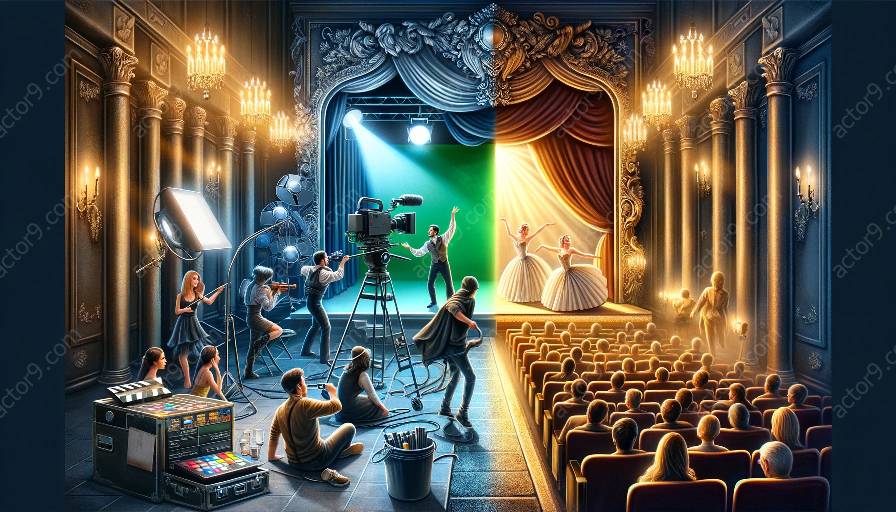The use of props and scenery is essential in both film and stage acting, contributing to the overall impact and storytelling of a performance. In this comprehensive guide, we will explore the significance of props and scenery in both forms of acting, compare their roles in film acting versus stage acting, and discuss their relationship with the art of acting and theater.
Props and Scenery in Film Acting
In film acting, props and scenery play a significant role in creating a realistic and immersive setting for the audience. The careful selection and use of props can enhance the believability of a scene and help actors establish a connection with the audience. Additionally, detailed and authentic scenery can transport viewers to different times and places, enriching the storytelling experience.
Impact on Performance
Props and scenery in film acting greatly influence the actors' performances as they interact with their environment. The effective use of props can add depth to a character's personality and motivations, while the setting can evoke specific emotions that resonate with the audience.
Technical Considerations
From a technical standpoint, props and scenery in film acting require meticulous attention to detail. The art department and set designers collaborate to ensure that props and scenery are aligned with the overall vision of the film. Lighting and camera angles are also carefully coordinated to capture the essence of the props and scenery in a compelling manner.
Props and Scenery in Stage Acting
Similarly, props and scenery hold profound significance in stage acting, albeit with distinct considerations compared to film. On stage, props and scenery must be designed to be visible and effective from the audience's perspective, contributing to the live and dynamic nature of theatrical performances.
Engagement with the Audience
Unlike film acting, stage acting necessitates a heightened awareness of props and scenery to engage the audience effectively. The presence of physical props and intricate stage designs becomes integral to the audience's immersion in the live performance, demanding a different approach from actors in utilizing these elements.
Physicality and Adaptation
Stage actors often rely on the tactile nature of props and scenery to convey emotions and actions. The physicality of handling props and navigating the stage within the designated scenery becomes an inherent part of their performance, requiring adaptability and precision.
Film Acting vs. Stage Acting: A Comparative Analysis
When comparing the use of props and scenery in film acting versus stage acting, it's essential to recognize the unique demands and advantages of each medium.
Control and Realism
Film acting provides the opportunity for extensive control over the portrayal of props and scenery through the lens of the camera. The ability to capture minute details and create seamless transitions between different settings enhances the realism of film performances.
In contrast, stage acting limits control over props and scenery, as the live nature of the performance requires actors to adapt to fixed stage designs and manage physical props in real-time, contributing to a distinct form of realism and engagement.
Emotional Impact
The emotional impact of props and scenery in film acting is often intensified through close-ups and intricate cinematography, allowing for subtle and nuanced interactions between actors and their environment. On stage, the emotional impact is amplified through the physical presence of props and scenery, fostering a sense of interconnectedness with the performers.
Artistic Expression
Both film and stage acting offer unique avenues for artistic expression through props and scenery. In film, the visualization of intricate details in props and scenery can be meticulously crafted to convey specific themes and messages. On stage, the grandeur and physicality of props and scenery shape the overall aesthetic and serve as potent elements of theatrical storytelling.
Props, Scenery, and the Art of Acting
At the heart of it all, props and scenery intersect with the art of acting, influencing the creative choices and performances of actors in both film and stage productions.
Character Development
Props and scenery serve as extensions of characters, aiding in their development and adding layers of complexity to their personas. The interaction between actors and their surroundings, whether on screen or on stage, contributes to the holistic portrayal of characters and their journeys.
Storytelling and Atmosphere
Through props and scenery, actors contribute to the creation of compelling narratives and atmospheric settings that captivate audiences. Whether conveying a sense of mystery in a film noir or evoking a specific historical era on stage, props and scenery serve as integral storytelling tools.
Collaborative Process
The use of props and scenery underscores the collaborative nature of acting and theater, requiring seamless coordination between actors, directors, set designers, and technical teams. Each element undergoes careful consideration to align with the overarching vision of the production, highlighting the interconnectedness of various artistic disciplines.
Acting & Theater: A Holistic Perspective
While the use of props and scenery distinguishes film and stage acting, they both converge within the broader context of acting and theater, embodying the multidimensional nature of the performing arts.
Artistic Immersion
Props and scenery engender a sense of artistic immersion, enabling actors to fully inhabit their roles and transport audiences to diverse fictional worlds or historical settings, embodying the essence of the theatrical experience.
Evolution of Techniques
As acting and theater continue to evolve, the incorporation of props and scenery reflects contemporary advancements in artistic techniques and design, enriching the storytelling potential across different mediums.
Cultural Impact
Props and scenery not only enrich individual performances but also leave a lasting cultural impact. Iconic props and memorable stage designs have the power to resonate with audiences across generations, becoming emblematic of the enduring legacy of acting and theater.
In conclusion, the use of props and scenery in film and stage acting transcends mere set adornments; they are integral components that shape narratives, evoke emotions, and forge indelible connections between actors and audiences, perpetuating the transformative allure of the performing arts.















































